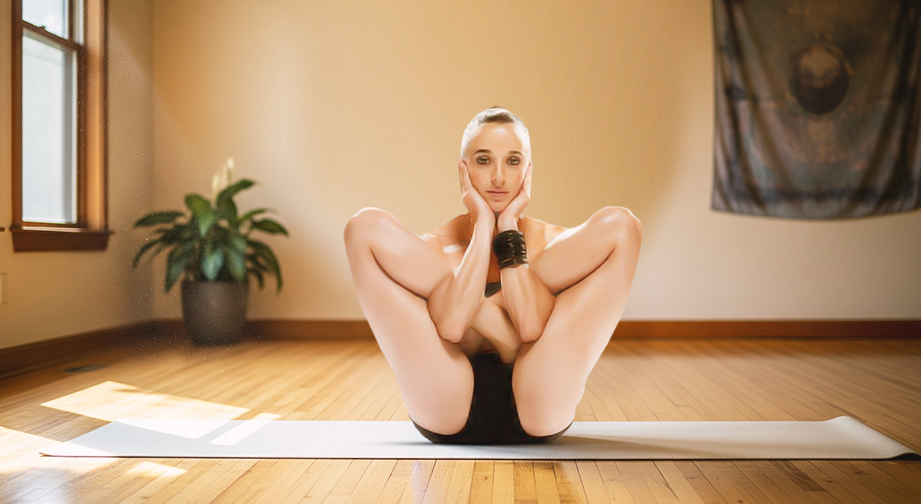Garbha Pindasana (Embryo in Womb Pose – Sitting): A Gentle Yoga Guide for Beginners
Introduction
Garbha Pindasana, also known as the Embryo in Womb Pose, is a seated yoga asana that gently wraps your body into a position reminiscent of a developing embryo. In Sanskrit, “Garbha” means womb, and “Pinda” means embryo or fetus. The essence of this pose is calmness and self-nurturing.
If you’ve ever felt stiff or restless after sitting at your desk all day, this pose is your cozy reset button—helping you feel safe, supported, and soothed from the inside out.
Step-by-Step Guide: How to Practice Garbha Pindasana

- Sit on your mat in Padmasana (Lotus Pose). If Lotus is challenging, try a simple cross-legged position.
- Slide your hands through your legs: Gently reach your arms through the space between your calves and thighs, bringing your hands out through the sides of your knees.
- Bend your elbows and bring your hands up, ideally towards your ears or cheeks. You may clasp each ear or touch your face softly.
- Keep your spine tall, relax your shoulders, and gently close your eyes.
- Focus on your breath:
- Inhale deeply, lengthening your spine.
- Exhale slowly, drawing your knees a little closer to your chest if comfortable.
- Hold the posture for 20–40 seconds (or 5–8 gentle breaths). Release and repeat for up to 3 rounds.
Beginner’s Modification: Can’t do Lotus Pose yet? Just sit cross-legged and bring your arms around your knees, hugging yourself gently.
To Intensify: Try rocking gently back and forth, balancing on your tailbone for core engagement.
Alignment & Safety Tips for Garbha Pindasana
- Lengthen through your spine; avoid rounding the upper back.
- Breathe naturally, never holding your breath.
- Relax your face and jaw throughout the pose.
- Common Mistake: Forcing the knees into Lotus—always respect your flexibility or use cross-legged posture.
- Safety: Skip Garbha Pindasana if you are pregnant, have recent hip/knee injuries, or severe lower back issues.
Benefits of Garbha Pindasana
Physical Benefits
- Boosts hip and knee flexibility
- Strengthens core and pelvic floor
- Improves posture and spinal alignment
- Stimulates digestive organs
Mental Benefits
- Encourages inner calm and emotional balance
- Reduces anxiety and stress
- Promotes a sense of safety and self-nurturing
Energy / Chakra Connection
- Activates the Swadhisthana (Sacral) Chakra – supports emotional flow and creativity
- Calms overactive thoughts and brings grounding energy
Contraindications: Who Should Avoid Garbha Pindasana?
- Pregnant or menstruating individuals (use gentle seated alternative like Sukhasana instead)
- Recent or severe hip, knee, or lower back injuries
- High blood pressure or hernia: only with guidance from a yoga therapist
Safe Alternative: Hug knees into chest in a simple cross-legged seated position or try Child’s Pose (Balasana).
Beginner’s Tips & Variations
- Use props: Sit on a folded blanket or bolster to elevate hips and ease knees.
- If legs don’t cross comfortably, hug your knees and rest hands on shins.
- Advanced: Balance on your sit bones, lift feet off the floor and gently rock.
- If hands don't reach through, use a yoga strap to gently bind knees together for extra support.
How to Include Garbha Pindasana in Your Yoga Practice
- Best as a main practice or cool-down posture to tap into deep calm.
- Pairs well with:
- Padmasana (Lotus Pose) or Sukhasana (Easy Seat)
- Child’s Pose (Balasana) for relaxation
- Boat Pose (Navasana) for building core
Mind-Body Connection & Spiritual Significance
Practicing Garbha Pindasana is a way to turn inward and reconnect with your center. As you curl into yourself, bring kind awareness to your breath and inner sensations. The womb-like position symbolizes security, trust, and self-care—nurturing your emotional and creative energies (Swadhisthana Chakra).
Summary Box: Garbha Pindasana
- Asana Name: Embryo in Womb Pose (Garbha Pindasana)
- Level: Beginner – Intermediate
- Focus Areas: Hips, core, ankles, mind
- Duration: 20–40 seconds, repeat up to 3 rounds
- Best Time to Practice: Morning or evening (best on an empty stomach)
Frequently Asked Questions about Garbha Pindasana
- Can I practice Garbha Pindasana without Lotus Pose?
Yes! Simply sit cross-legged and hug your knees or wrap arms around without forcing.
- What if my hips or knees hurt?
Sit up on a prop or try Child’s Pose instead.
- How often should I include this pose?
2–3 times per week or whenever you crave a gentle, nurturing stretch.
Remember: Garbha Pindasana (Embryo in Womb Pose) is about comfort, not perfection. Listen to your body, move gently, and cherish your practice!